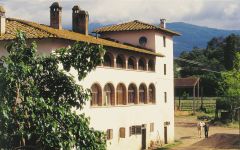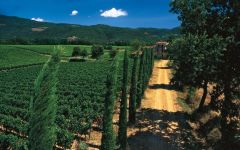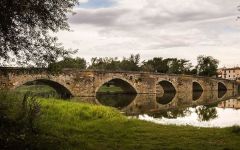Tenuta Sette Ponti Oreno 1999
-
Wine
Spectator


Product Details
Your Rating
Somm Note
Winemaker Notes
-Wine Spectator
Tenuta Sette Ponti's second release was the 1999 vintage Oreno, named after a stream which runs through the estate. The blend of Sangiovese, Cabernet Sauvignon and Merlot from vines of an average age of 15 to 20 years results in an internationally-styled, super Tuscan wine. The wine's dense, violet color suggests its Cabernet component which is confirmed in aromas of cassis, black stone fruit and wild cherries offset by notes of herbs, spice and sweet oak. These carry into ripe, densely fruited palate marked by firm yet elegant tannic structure and integrated vanilla oak, ending in a long, refined finish.
50% Sangiovese, 25% Cabernet Sauvignon, 25% Merlot
Professional Ratings
- Wine Spectator
Other Vintages
2021-
James
Suckling -
Robert
Parker -
Wine
Enthusiast
-
James
Suckling -
Wine
Spectator -
Robert
Parker
-
James
Suckling -
Robert
Parker -
Wine
Spectator
-
James
Suckling -
Robert
Parker -
Wine
Spectator
-
James
Suckling -
The Somm
Journal -
Wine
Spectator
-
James
Suckling -
Robert
Parker -
Wine
Spectator -
Wine
Enthusiast
-
James
Suckling -
Wine
Spectator -
Robert
Parker -
Wine &
Spirits
-
James
Suckling -
Tasting
Panel -
Robert
Parker -
Wine
Spectator
-
James
Suckling -
Wine &
Spirits -
Wine
Spectator
-
James
Suckling -
Robert
Parker -
Wine
Spectator
-
James
Suckling -
Wine
Spectator
-
James
Suckling -
Wine
Spectator
-
James
Suckling -
Robert
Parker -
Wine &
Spirits
-
James
Suckling -
Robert
Parker -
Wine
Spectator
-
Wine
Enthusiast -
Wine
Spectator -
Robert
Parker
-
Wine
Spectator -
Robert
Parker
-
Wine
Spectator -
Wine
Enthusiast -
Wine &
Spirits
-
Wine
Spectator -
Wine
Enthusiast -
Robert
Parker
-
Wine
Spectator -
Wine
Enthusiast -
Robert
Parker
-
Wine
Spectator -
Robert
Parker
-
Wine
Spectator








The estate of Sette Ponti lies in the heart of the Chianti zone, fifteen miles northwest of the city of Arezzo just past the village of San Giustino Valdarno. The Via del Monte, known locally as the Via dei Sette Ponti, leads into a beautiful hidden valley and to the estate. The name Sette Ponti, or "seven bridges," refers to the seven bridges crossing the Arno River on the road from Arezzo to Florence. Erected in the mid 13th century, it took nearly forty years to build, and is perceptible in the right far background of Leonardo DaVinci's Mona Lisa.
Tenuta Sette Ponti, is, like many Tuscan estates, multi-faceted. The 750-acre property supports livestock and mixed agriculture, and although viticulture is not new to the estate, winemaking is; the yield of the property's vineyards was until 1997 sold to various respected Tuscan wine producers, among them Piero Antinori. Dr. Moretti's enjoyment of wine led him to ask Antinori if the estate vineyards could produce great wines, and Antinori thought they could. The estate has since been transformed through the consultation of respected oenologist Carlo Ferrini and his assistant, Gioia Cresti; Gilbert Bouvet, one of France's most skilled viticulturalists; and agronomist Benedetto d'Anna.
